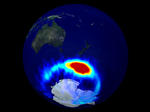Aurora
|

|
Electrons moving along the Earth's geomagnetic field lines can be directed into the upper atmosphere. These electrons can collide with atmospheric atoms sending them into an excited state. When these excited atoms decay back to their ground state, photons of visible light can be emitted, forming the aurora.
|
|
MOVIE
|
ID
|
TITLE
|

|
2964
|
IMAGE Views of the Aurora from Space
|

|
2891
|
Animated Earth: Aurora over the North Pole on April 17, 1999
|

|
2861
|
Reconnection: Solar Wind Breaches the Earth's Magnetic Shield
|

|
2857
|
Geomagnetic Storm: November 2003
|

|
2719
|
Auroral Elements
|

|
2445
|
IMAGE/HENA views Oxygen in the Magnetosphere (blue version)
|

|
2444
|
IMAGE/HENA views Oxygen in the Magnetosphere (rainbow version)
|

|
2043
|
Stills of the Polar Visible Aurora from July 16, 2000
|

|
2040
|
Stills of the Polar Visible Aurora from October 22, 1999
|

|
2038
|
Stills of the Polar Visible Aurora from January 10, 1997
|

|
2037
|
Polar Visible Aurora Animation: July 16, 2000
|

|
1211
|
Polar Visible Aurora Animation: July 13, 2000
|

|
1210
|
Polar Visible Aurora Animation: July 15, 2000
|

|
1206
|
Polar Visible Aurora Animation: July 15, 2000 to July 16, 2000
|

|
1175
|
Aurora w/o Earth Inset
|

|
1173
|
Aurora Close-up w/Earth inset
|

|
1171
|
Aurora with Earth inset
|

|
806
|
Digital Earth Workbench: Aurora
|

|
788
|
Polar Visible Aurora: Normal Solar Wind Conditions on November 13, 1999 over the North Pole
|

|
786
|
Polar Visible Aurora: Low Solar Wind Conditions on May 11, 1999 over the North Pole
|

|
785
|
Polar Visible Aurora: High Solar Wind Conditions on April 17, 1999 over the North Pole
|

|
784
|
Polar Visible Aurora: North Pole Comparison between May 11, 1999 and November 13, 1999 (Grid)
|

|
783
|
Polar Visible Aurora: North Pole Comparison between May 11, 1999 and November 13, 1999 (Continents)
|

|
778
|
Polar: PIXIE at Perigee on May 11, 1999 (North)
|

|
777
|
Polar: PIXIE at Apogee on May 11, 1999 (North)
|